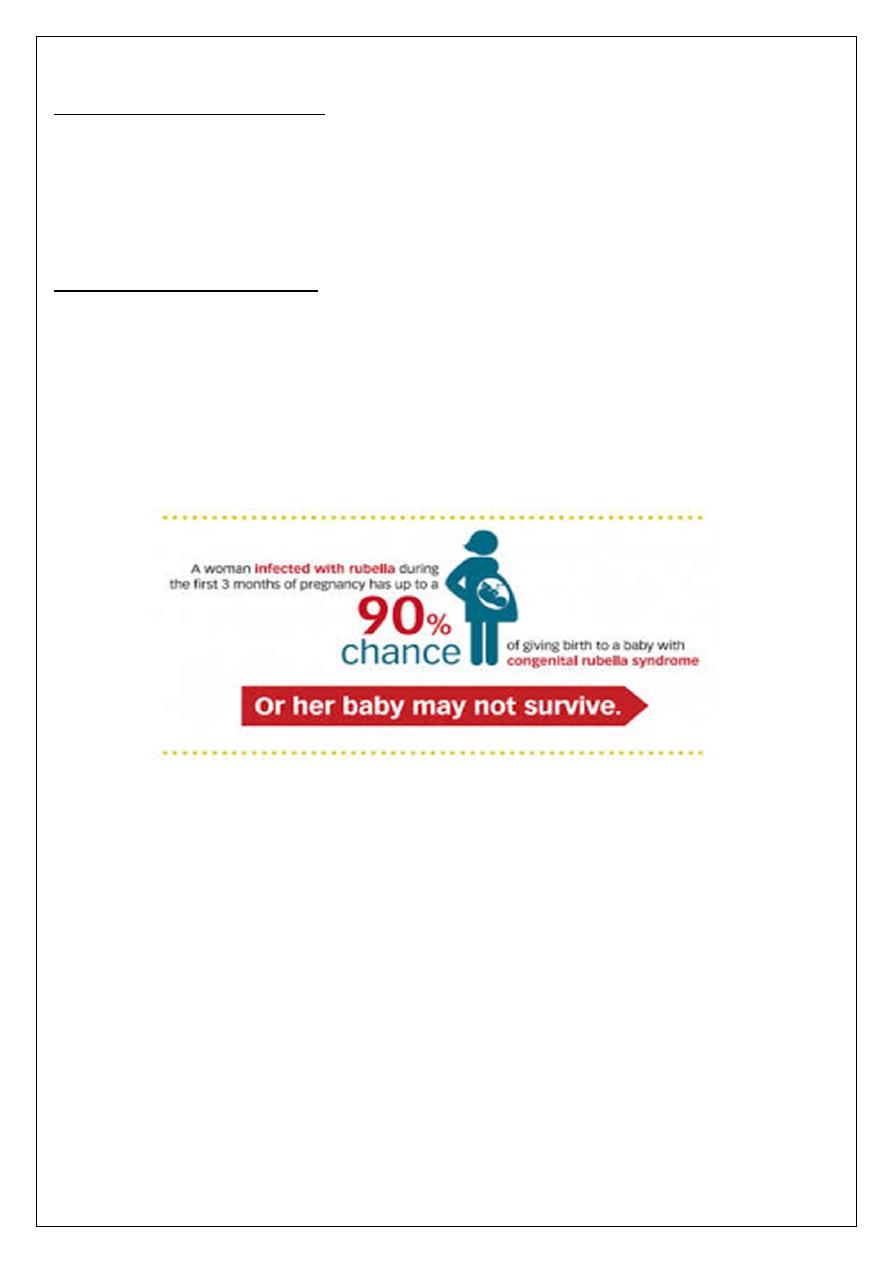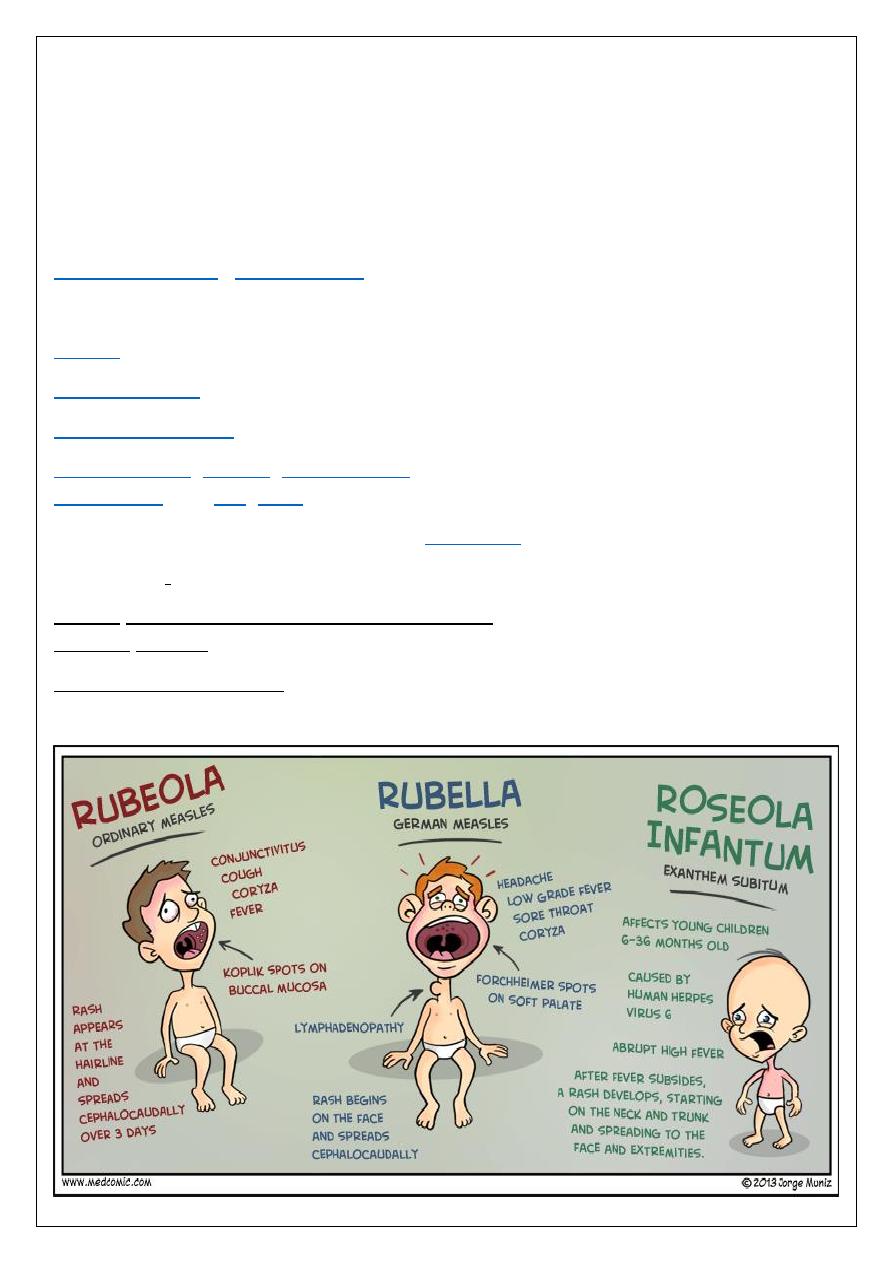
COMMUNITY MEDICINE DR.HADEEL FADEHEL
RUBELLA AND MUMPS LEC: 5
Rubella
Key facts:-
-Rubella is a contagious, generally mild viral infection that occurs most often in children
and young adults.
-Rubella infection in pregnant women may cause fetal death or congenital defects
known as congenital rubella syndrome (CRS).
-Worldwide, over 100 000 babies are born with CRS every year.
-There is no specific treatment for rubella but the disease is preventable by vaccination.
-
:
Identification
-Mild febrile viral disease
-with diffuse rash.
-Children usually present few or no constitutional symptoms.
-In adults may experience of low grade fever , headache , malaise, mild corysa, &
conjunctivitis , lymphadenopathy( ccic CF & precedes the rash by 5-10 days)
-Up to half of infections occur without recognized rash .
-Leukppenia is common
-thrombocytopenea can occur ,
-arthralgia , arthritis.
-Encephalitis & thrombocytopenia ( rare complication in children , encephalitis occur
more in adults )
-
:
Case classification
1-Suspect: any generalized maculopapular rash with fever, lymphadenopathy
2-Probable: a case that meets the clinical case definition, has no or noncontributory
serological or virological testing, and is not epidemiologically linked to a laboratory
confirmed case.
3-Confirmed: a case that is laboratory confirmed (isolation of rubella virus or significant
rise in rubella antibody level by standard serologic assay, or positive serologic test for
rubella IgM antibody) or that meets the clinical case definition and is epidemiologically
linked to a laboratory - confirmed case.

-
:
Rubella is important because
.
Of its ability to produce anomalies in the developing fetus
.
Congenital rubella syndrome (CRS) occurs in up90% of infants born to women who are
infected with rubella during the 1st trimester of pregnancy
.
Infected fetus are at risk of IUD , spontaneous abortion , congenital malformation
.
-
:
Congenital rubella syndrome
-Children with CRS can suffer hearing impairments, eye and heart defects and other
lifelong disabilities, including autism, diabetes mellitus and thyroid dysfunction – many
of which require costly therapy, surgeries and other expensive care.
-The highest risk of CRS is in countries where women of childbearing age do not have
immunity to the disease (either through vaccination or from having had rubella). Before
the introduction of the vaccine, up to 4 babies in every 1000 live births were born with
CRS.
-Large-scale rubella vaccination during the past decade has practically eliminated rubella
and CRS in many developed and in some developing countries.
-In April 2015, the WHO Region of the Americas became the first in the world to be
declared free of endemic transmission of rubella.
-CRS rates are highest in the WHO African and South-East Asian regions where vaccine
coverage is lowest.
-The syndrome (CRS) follows intrauterine infection by Rubella virus and comprises
cardiac, cerebral, ophthalmic and auditory defects. It may also cause prematurity, low
birth weight, and neonatal thrombocytopenia, anaemia
.
-The risk of major defects or organogenesis is highest for infection in the first trimester.
Many mothers who contract rubella within the first trimester either have a miscarriage
or a still born baby. If the baby survives the infection, it can be born with severe heart
disorders (Patent ductus arteriosus being the most common), blindness, deafness, or
other life threatening organ disorders. The skin manifestations are called "blueberry

muffin lesions." For these reasons, Rubella is included on the TORCH complex of
perinatal infections
The
TORCH complex was originally considered to consist of four conditions
with
the
"
TO
"
referring to
"
Toxoplasma
."
The four-term form is
still used in many modern
references
and the capitalization
"
ToRCH
"
is sometimes used in these contexts
.
Alternatively
,
the
"
O
"
is redefined as
"
other
,"
and the acronym is
spelled out as follows
T
–
–
Other infections (see below)
R
–
C
–
H
–
The
"
agents
other
"
included under
O
are
and
may
also be included among
"
other agents
:
for
TORCHES
xoplasmosis
TO
,
ubella
R
,
ytomegalovirus
C
,
rpes
HE
simplex
,
yphilis
S
.
-
:
Differentiation of rubella

-
Diagnosis :
-clinical dx
-lab : significant rise in specific antibody between acute & convalescent phase by ELISA
OR by presence of rubella specific IgM indicating recent infection
Virus may be isolated from the pharynx 1 wk before & up to 2 wk after onset of rash
-
Blood , urine , or stool specimens may yield virus
.
-
Virus may be shed from the throat and urine for as long as year
-
--------------------------
Infectious agent : Rubella virus ( family Togaviridae)
Occurrence
:
-Worldwide, usually endemic except in remote & isolated communities that have
epidemics every 10-15 years
.
it is prevalent in winter & spring
-
.
-Reservoir: humans
Mode of transmission
-
1-Contact with nasopharyngeal secretions of infected person
.
2-Infection by droplet spread or direct contact with patients
.
3-Infants with CRS shed large quantities of virus in their pharyngeal secretions and
urine and serve as a source of infection to their contacts
.
Incubation period : from 14-17 days with range 0f 14-21 days
.
Period of communicability : for about 1 wk before and at least 5 days after onset of rash
-
:
Susceptibility & resistance
Suscp. Is general after loss of transplacentally acquired maternal antibodies
-
.
-Active immunity is acquired by natural infection or by immunization , it is usually
permanent or lifelong
.
-
:
Methods of control
-prevent Rubella control is needed primarily to
defect in the offspring of women who infected during pregnancy

PREVENTIVE MEASURES:-
A-
1-educate the general public on mode of transmission & need for rubella
immunization
2-live attenuated rubella virus vaccineNinety-five percent of those who receive
the MMR or rubella vaccine at one year of age or older are immune after the first
dose. Immunity is lifelong
-Immunization of all children is recommended at 12-15 months of age part of MMR ,
with 2nd dose of MMR at school entry or at adolescence
.
-Rubella vaccines are available either in monovalent formulation (vaccine directed at
only one pathogen) or more commonly in combinations with other vaccines such as with
vaccines against measles (MR), measles and mumps (MMR), or measles, mumps and
varicella (MMRV)
Vaccine is recommended for:-
*
non pregnant females without contraindication
.
*
*
Susceptible young adults who have contact with young children
*
*medical personnel should be immune to rubella , particularly those who are contact
with patients in prenatal clinics
-
:
Vaccine contraindications
immunodeficiency or on immunsuppressive therapy
.
*
*
*women known to be pregnant or who are planning to get pregnant in the next 3
months
In some countries routine immunization is
given to girls between 11&13 years of
age with or without prier antibody
testing
.
3-in case of natural infection early in pregnancy ,abortion should be considered
because of
high risk of damage to the fetus
.
4-IG given after exposure early in pregnancy may not prevent infection or viremia
, but it modify or suppress symptoms. It is sometimes given in huge doses ( 20 ml)
to a susceptible pregnant women exposed to the disease who would not consider
abortion under any circumstances , but its value has not been established
.
-
:
Control of patient , contact and immediate environment
-
B
1-report to local health authority: all cases of rubella should be reported , report is
obligatory

2-isolation: in hospitals & institutions, patients suspected of having rubella should
be managed under contact isolation percussions & placed in a private room to
prevent exposure of non-immune pregnant women
Exclude children from school & adults from work for 7 days after onset of rash
.
3-concurrent disinfection: none
4-quarantine: none
5-immunization of contact: immunization , if not contraindicated, will not
necessary prevent infection or illness
.
*Passive immunization with IG is not indicated
6-investigation of contact & source of infection: identify pregnant female
contacts, especially those in the 1st trimester
.
7-specific treatment: none
-
:
epidemic measures
-
C
1-prompt reporting of all confirmed & suspected cases & immunization of all
suspected contacts are needed for outbreak control
.
2-the medical community & general public should be informed about rubella
epidemics in order to identify & protect suspected pregnant women
.
-
:
WHO response
WHO recommends that all countries that have not yet introduced rubella vaccine should
consider doing so using existing, well-established measles immunization programmes.
To-date, three WHO Regions have established goals to eliminate this preventable cause
of birth defects
.
By the end of 2015
Reduce global measles deaths by at least 95% compared with 2000 levels
.
Achieve regional measles and rubella/congenital rubella syndrome (CRS) elimination
goals
.
By the end of 2020
Achieve measles and rubella elimination in at least 5 WHO regions
.
-
:
The strategy focuses on the implementation of 5 core components
1-achieve and maintain high vaccination coverage with 2 doses of measles- and rubella-
containing vaccines
;
2-monitor the disease using effective surveillance, and evaluate programmatic efforts to
ensure progress and the positive impact of vaccination activities
;

3-develop and maintain outbreak preparedness, rapid response to outbreaks and the
effective treatment of cases
;
communicate and engage to build public confidence and demand for immunization
;
4-
-
5-perform the research and development needed to support cost-effective action and
improve vaccination and diagnostic tools
--------------------------------------------------------------------------------------------------------------------
.
-
:
MUMPS
Acute viral disease characterized by:-
-
-Fever ,swelling and tenderness of one or more salivary glands, usually parotid & some
time sublingual or submaxillary glands
-Mumps is a contagious disease caused by a virus. and can be protect against mumps
with vaccination
.
-
:
The most common symptoms include
:
Fever
-
Headache
-
Muscle aches
-
Tiredness
-
Loss of appetite
-
Swollen and tender salivary glands under the ears on one or both sides (parotitis)
-
-Symptoms typically appear 16-18 days after infection, but this period can range from
12-25 days after infection
.
-Some people who get mumps have very mild or no symptoms, and often they do not
know they have the disease
.
-Most people with mumps recover completely in a few weeks
.
-
:
Transmission of Mumps
-Mumps is a contagious disease caused by a virus. It spreads through saliva or mucus
from the mouth, nose, or throat. An infected person can spread the virus by
-coughing, sneezing, or talking
,
-sharing items, such as cups or eating utensils, with others, and
-touching objects or surfaces with unwashed hands that are then touched by others
.

-Mumps likely spreads before the salivary glands begin to swell and up to five days after
the swelling begins
.
*-mastitis , occur in up to 30% of female older than 15 years
*
sterility, rare
-
Incubation period
16-18 days (Range: 14-25 days).
Period of communicability
Virus has been isolated from saliva (7 days before to 9 days after the onset of parotitis)
and from urine (6 days before to 15 days after the onset of parotitis). Maximum
infectiousness occurs between 2 days before to 4 days after onset of illness. Inapparent
infections can be communicable.
-
:
Known complications of mumps include
Mumps can occasionally cause complications, especially in adults.
-
Complications include:
1-inflammation of the testicles (orchitis) in males who have reached puberty; rarely does
this lead to fertility problems
2-inflammation of the brain (encephalitis)
3-inflammation of the tissue covering the brain and spinal cord (meningitis)
4-inflammation of the ovaries (oophoritis) and/or breast tissue (mastitis)
5-deafness
-Mumps infection during the first trimester of pregnancy is associated with a high (25%)
incidence of spontaneous abortion, but there is no firm evidence that mumps during
pregnancy causes congenital malformations
Acute mumps infection confirm by :
significant rise in IgG , IgM antibodies
-
Positive mumps viral cultures
-
Methods of control
A-preventive measures
:
public education to encourage mumps immunization
.
1-
2-live attenuated mumps V irus vaccine (MMR) . More than 95% of children develop
immunity that is long – lasting & may be lifelong
.

-Vaccine may be taken any time after 1 year of age , preferably as MMR at 12-15 months
of age. 2nd dose recommended at 4-6 years
.
-However, in an accelerated MMR schedule , or a catch –up opportunity , the second
dose may be given as soon as 1 month after the first dose
.
-Special effort should be made to immunize before puberty all persons with no definite
history of mumps or mumps immunization
.
-
:
Vaccine is contraindication in
immunosuppressed
-
*
pregnant females or females trying to get pregnant in the next 3 months
.
-
B- Control of patient , contact and immediate environment
1-selectively reportable
2-isolation : resp isolation & private room for 9 days from onset of swelling to, less if
swelling is subside, exclusion from school & workplace until 9 days after onset of
parotitis if susceptible contacts( those not immunized) are present
.
concurrent disinfection : of articles soiled with nose & throat secretions
.
3-
4-Quarantine : exclusion of susceptible from school or the workplace from the 12th
through the 25th day after exposure if other susceptible are present
.
-
5-immunization of contact : immunization protected against infection from subsequent
exposure, IG is not effective & not recommended
.
6-investigation of contact & source of infection: susceptible contact should be
immunized
.
7-specific treatment : none
C-Epidemic measures:
Immunize susceptible, especially those at risk of exposure
-
*
-serologic screening to identify susceptible is impractical & un necessary, since there is
no risk in immunizing those who are already immune
